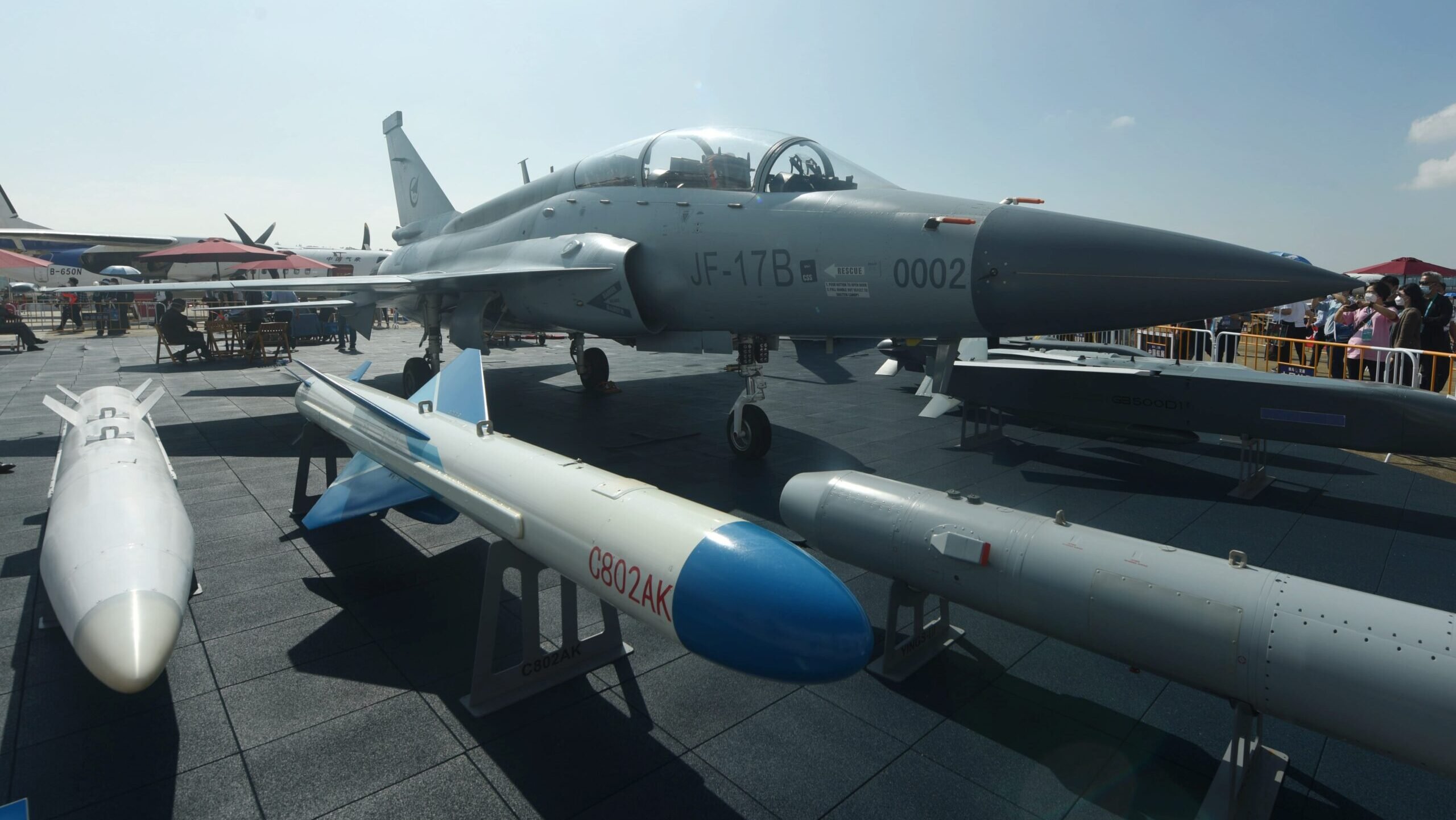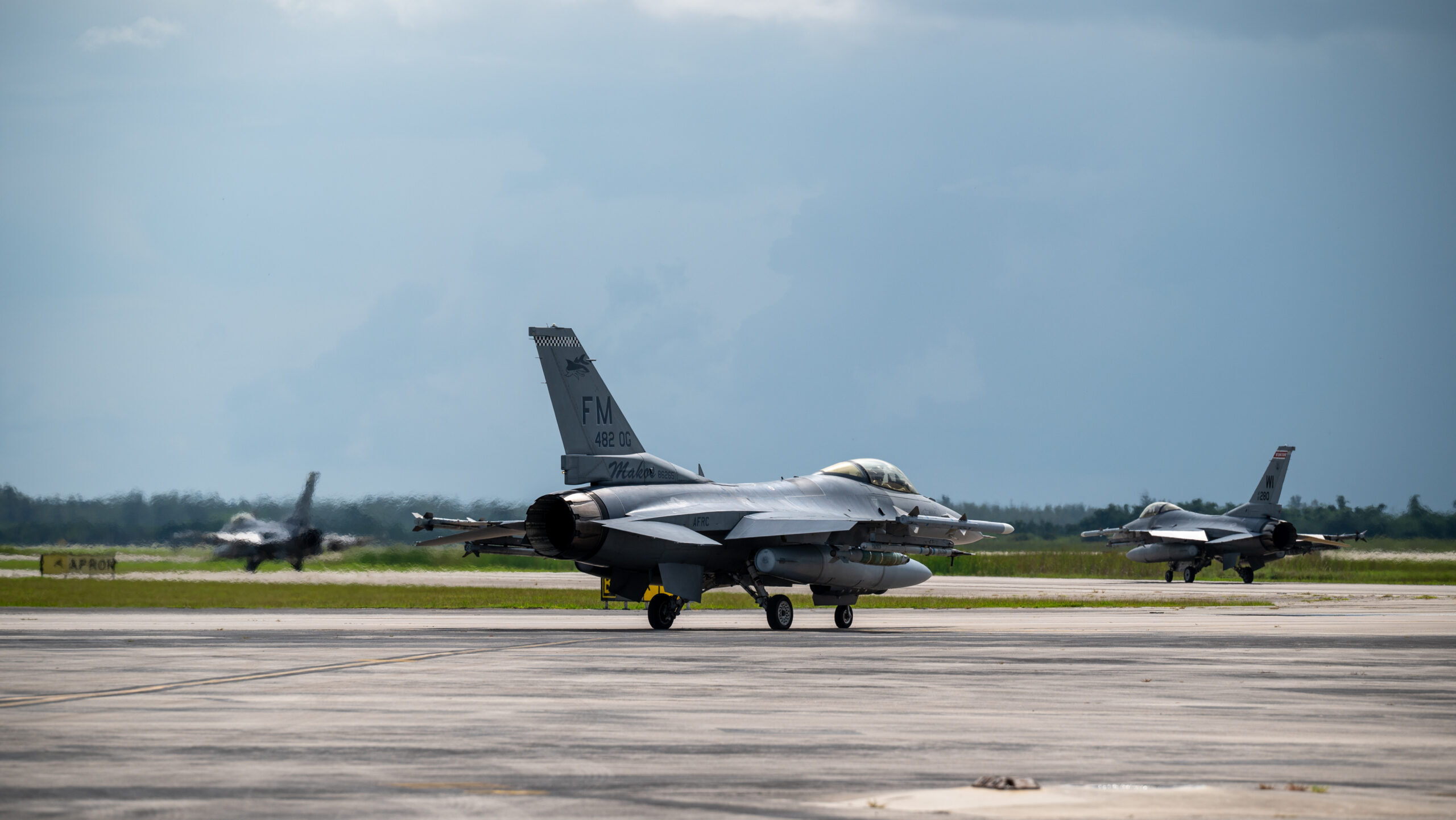
A photo taken on Nov. 9, 2022 shows the JF-17 Thunder fighter aircraft, a two-seater combat trainer, at the Airshow China in Zhuhai, Guangdong province, China. (CFOTO/Future Publishing via Getty Images)
FT. LAUDERDALE, Fla. — The global influence struggle between the United States and the People’s Republic of China has quietly arrived in America’s backyard, with Washington attempting to fend off Beijing establishing a sizeable military relationship with Argentina.
The competition, as it so often does between large powers, is playing out through a defense industrial decision: Namely, whether Buenos Aries buys second-hand Danish F-16 A/B Fighting Falcons or newly-made Chengdu JF-17 Thunder Block Three fighters from China.
The Fuerza Aérea Argentina (Argentine Air Force or FAA) had been evaluating three options for its next fighter aircraft, one of which had been the Indian-built Tejas Light Combat Aircraft (LCA). However, local news reports say the LCA has since been eliminated. According to the national daily La Nacion, the decision rests with a team of experts from the Argentine Defence Forum, which have been analyzing all alternatives presented for modernization of the Armed Forces.
Meanwhile, multiple local outlets say Washington is putting pressure on Buenos Aires to pick the F-16 in order to deny China an expanded footprint in Latin America.
Concern about China increasing its footprint in Latin America is hardly a secret. In August, US Southern Command head Gen. Laura Richardson spelled it out clearly, saying Chinese investment in the region means Beijing is “on the 20-yard line of our homeland, or we could say that they’re on the first and second island chain to our homeland and the proximity in terms of this region.”
“There’s not a Chinese base yet in this hemisphere. But I see with all of this critical infrastructure investment,” Richardson added later, “that there could possibly be someday.”
In late July it was reported DSCA had a notification to the US Congress authorizing third-party transfers to Argentina, for up to six F-16 Block 10 and up to 32 Block 15 Danish F-16 aircraft, with a total estimated value of US $338 million dollars. Although these Danish aircraft are older F-16A/B Block series, they all had completed a mid-life upgrade compatible with the C/D-series configuration by 2005.
Speaking to Breaking Defense on background, US State Department officials confirmed transfer to Argentina had been authorized, but without specifying any numbers. DSCA notifications tend to be a “ceiling” for total program acquisition over multiple procurements and are not the total quantity for an initial buy, meaning the reported figures may not be final.
There are consequences, wrote La Nacion in July, that “any purchase of weapons implies a political commitment with the country from which it is purchased and, also, with those to whom it turns its back.” According to the multiple reports and various sources close to the subject, both the Argentine government and the US will have to resolve numerous delicate points to resolve the F-16 issue to everyone’s satisfaction.
The Chengdu Factor
The continuing motivation to entice Buenos Aires to become the second South America F-16 customer after Chile is “keeping a PRC military presence off the continent. The reason the US F-16 offer is being promoted aggressively is to kill this Chinese JF-17 sale,” a veteran DoD Latin American analyst told Breaking Defense.
The JF-17 was designed at Chengdu Aircraft Corporation (CAC) in Sichuan Province, where it was designated FC-1 枭龙 (Xialong or “Fierce Dragon”). The aircraft’s bifurcated inlet configuration was the product of a long-running project for an advanced derivative of the CAC’s J-7, a reverse-engineered copy of the Mikoyan MiG-21.
Continuing historical cooperation between the PRC and Pakistan, the renamed “Joint Fighter” JF-17 production line was established at the Pakistan Aeronautical Complex (PAC) in Kamra. Its final design differed substantially from originally proposed concepts by the use of foreign on-board electronics and a Russian-made NPO Klimov Isotov RD-93MA engine instead of a Chinese aeroengine. The Klimov powerplant is a single-engine installation of the MiG-29’s RD-33 engine that has the accessory pack rotated to the bottom of the engine.
Argentina has reportedly been offered 15-20 JF-17 fighter aircraft. While some units would be produced at the Pakistan Aeronautical Complex (PAC) in Kamra, there are reportedly also ongoing negotiations about co-production rights in Argentina — a naturally tempting offer for the local government.
But, despite JF-17 officially being an airplane built in Pakistan, the entire dialogue has been dominated by interactions with Chinese officialdom. As recently as May 2022 an Argentine delegation visited CAC and the collocated Aircraft Plant No. 132 in Chengdu where the first prototypes were assembled — rather than the full-scale production line in Pakistan.
CAC is known as the far-more capable of the two major fighter aircraft production centers in the PRC, the other being the Shenyang Aircraft Works in the northern Dongbei region of China. The JF-17 “is what it is” said one former NATO defense analyst – “a low-cost lightweight fighter for countries that do not have deep pockets.”
By itself, the jet is no real threat to the US, but this initial JF-17 sale represents the proverbial “camel’s nose under the tent,” the analyst said — a way for China to make inroads in what the US considers its backyard. And naturally, any Chinese jet buy would come with Chinese infrastructure — PRC provided contractors and trainers, at the very least — the kind of footprint Richardson raised concerns about over the summer.
If the JF-17 lands in Argentina, the analyst added, it’s possible China would offer a cheap deal for the J-10 fighter, a CAC product with a longer range and payload capacity. Or, potentially, the J-20, a design that incorporates a stealthy, blended-shape and can reach targets up to 1,200 miles from base. Either would benefit China’s goal of having a greater military footprint in the region.

Three F-16s from the 93rd Fighter Squadron prepare for takeoff at Homestead Air Reserve Base on Aug. 3, 2022, during the Golden Gecko Airmen Readiness Exercise 2023. The drill, held from August 1-3, tested the 482d Fighter Wing’s capabilities in contested, degraded, and operationally limited environments, including Chemical, Biological, Radiological, and Nuclear exposure scenarios. (U.S. Air Force photo by Tech. Sgt. Lionel Castellano)
“The real nightmare for a number of defense planners in Washington would be a customer in the southern hemisphere that would amount to an operating base for the latest Chinese defense and aerospace platforms in the US’s backyard,” the analyst said.
A secondary issue is the JF-17s acquired by Nigeria and Myanmar are equipped with the Russian RD-93MA engine, but the aircraft proposed to Argentina would be powered with a Chinese-built Guzhoi WS-13 泰山 (Tai Shan) engine.
The WS-13 design has been in the works for years and, like many other Chinese engine programs, experienced several setbacks in its development. The worry for US defense strategists is this is also the engine powering the PLAN’s Shenyang J-35, a carrier-capable fighter resembling a twin-engine clone of the US Navy’s F-35C.
“An export sale including the WS-13 means exactly what the US Navy does not want happening in China at this point,” the former intelligence analyst said. “It would create the industrial basis for its use on a wider scale. It could speed the introduction of this [J-35] fighter into service with the PLAN and present yet another naval challenge posed by Beijing.”
New v. Old
While there are definite advantages in the closer ties with the US an F-16 acquisition would facilitate, challenges remain if the Chinese bid is to be effectively blocked.
One concern is simply the age of the planes: 40-year-old jets that have already seen heavy use are a hard sell compared to the newer offering posed by China. Another concern is that the US generally splits the planes into one package and the weapons and sensors needed for their use into another, meaning Argentina would need to work out at least two different agreements, versus the JF-17, which is expected to be an all-up package.
The CAC JF-17 counter-proposal includes at least 15 units, all new-build, with options of negotiating a second batch and at a later date a third. “They are new airplanes and China offers a very complete armament and sensor package with few restrictions. The [negative] conditions would be, rather, political due to the twist that an operation with China would imply,” said the former analyst.
CAC is offering the usual grace period for subsequent payments. This has the advantage of no money up front, plus the aircraft could be in service far longer than the used Danish jets. However, critics are pointing to a previous procurement for a modernization of the nation’s radar systems, where PRC-made hardware proposed was disqualified “due to deficiencies in its quality,” according to reports.
But aside from potentially falling into another of the “debt traps” Beijing has become known for when dealing with poorer nations, a JF-17 acquisition could make Argentina appear to abandon its traditional alignment with the US and European nations. This could create obstacles should the FAA wish to acquire other US platforms. (Perhaps a good sign for Washington: Argentina just reached an agreement to acquire four used, American-made P-3 aircraft from Norway.)
The US is walking its own balance. Argentina’s Armed Forces have been almost exclusively aligned with the US in the past century. That “customer intimacy,” as US defense industry marketing personnel describe it, gives Washington an advantage in any procurement. But according to a report from La Nacion, the unspoken quid pro quo is that Buenos Aires would be banking on Washington’s support to resolve its debt repayment problems with the International Monetary Fund (IMF).
One other potentially tricky issue is the fact Denmark has also pledged F-16s to Ukraine’s defense. Over the last two months, Denmark, the Netherlands and Norway have all agreed to send some of their aircraft: 19 from the Royal Danish Air Force (RDAF), 42 from the Royal Netherlands Air Force (RNLAF) and possibly as many as 10 from the Royal Norwegian Air Force (RNoAF).
Satisfying both Argentina and Ukraine’s needs would seem to be difficult, the total number of the DSCA notification for Argentina, plus the 19 promised to Ukraine, would likely exceed the available inventory. Officials familiar with the offers to both air forces state Denmark will be allocating aircraft to meet Kyiv’s requirement, as well as the initial tranche offer to Buenos Aires; exactly how this will all shake out eventually remains unclear.
TAI exec claims 20 Turkish KAAN fighters to be delivered in 2028
Temel Kotil, TAI’s general manager, claimed that the domestically-produced Turkish jet will outperform the F-35 Joint Strike Fighter.


























